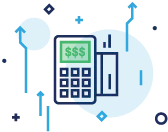TABLE OF CONTENTS
Looking at your credit card processing statement can be overwhelming. There are so many fees listed—pennies here, a few dollars there—that it can be hard to make sense of it all. In trying to decipher these fees, you may have read the phrase “ISA fee” or “Visa International Service Assessment” and had no idea why you were charged this particular fee. In this article, we dive into the Visa International Service Assessment fee—what it is, why you’re paying it, and how much it should cost—because no one should be paying credit processing fees they don’t understand.
What Is an ISA Fee?

The Visa International Service Assessment (ISA) fee is, just like it sounds, an international service charge. Visa introduced this fee in 2008 to cover the costs and increased risks associated with foreign transactions.
The ISA fee falls into a category of credit card processing fees known as “assessment fees.” Below are the three major categories of fees:
- Interchange Fees. These are the largest chunk of the fees you pay each month. The card-issuing banks charge these fees. For example, if your customer uses a Bank of America rewards card, Bank of America charges you an interchange fee.
When Is the ISA Fee Charged?
Visa charges the Visa International Service Assessment fee any time a United States-based business accepts a Visa credit or debit card issued in another country. Because it’s such a specific circumstance, you may only see this fee once in a while unless your business is in a tourist-heavy area.
While the ISA fee is Visa-specific, MasterCard and Discover impose similar fees for cards issued abroad.
How Much Does the ISA Fee Cost?
Coming in at 1 percent as of 2022, the ISA fee is one of the highest assessment fees. On a transaction for which you’d be charged an ISA fee, you can also expect to pay additional assessments from Visa, such as the standard Dues & Assessments fee (0.13 percent for debit cards and 0.14 percent for credit cards) and another international fee known as the International Acquirer Fee at 0.45 percent. The total percentage-based assessments for this type of transaction would total 1.59 percent. This is in addition to the interchange fees and processor fees.
ISA Fee vs IAF Fee
The only difference between the ISA fee and the International Acquirer Fee (IAF) is the amount, as Visa charges them under the same conditions.
- The International Service Assessment Fee: 1 percent on international transaction volume
- The International Acquirer Fee: 0.45 percent on international transaction volume
For example, if you process a transaction for $100 with an internationally-issued Visa card, you can expect to pay an ISA fee of $1.00 and an IAF of $0.45.
Who Pays the International Service Charge?
As the business entity accepting the card, you are responsible for paying this fee. Unfortunately, this, along with other credit card fees, is a cost of doing business that isn’t likely to go away any time soon.
With that said, it’s worth evaluating your effective rate (your average costs incurred running transactions) to ensure your profit margin covers the costs you pay. While some states prohibit applying surcharges to credit card payments, it’s perfectly legal to build the cost of credit card processing into your prices.
To calculate your effective rate percentage, divide the total number of fees you pay in a month by your total sales volume in a month, then take that number and multiply it by 100.
Total number of fees you pay in a month ÷ Total sales volume for that month × 100 = Effective Rate Percentage
Where Is the ISA Fee Located on Your Statement?
The ISA fee may be anywhere on your merchant processing statement. Also, it may have a different label depending on your processor and your pricing structure. Below are a few tips to help you locate it.
Pricing Structure
The most common structures are interchange-plus, tiered, and flat-rate pricing.
- Interchange–Plus. If you’re on an interchange-plus pricing structure, you may find a section dedicated to assessment fees. The Visa International Service Assessment charge will be included in this section. If there’s no section for assessment, scan the fees line-by-line to find it.
- Flat Rate. If you’re on a flat-rate pricing structure, you may not see this fee listed on your statement. Instead, it’s bundled into your flat rate. Don’t confuse this for not paying the Visa ISA fee. Though it’s not itemized on your bill, you are still paying for it.
- Tiered. If you’re priced on a tiered pricing structure, you may see this fee in an assessment section (similar to interchange-plus) or not at all (similar to flat-rate). If there’s no section for assessment fees, scan the fees line-by-line to try to find it.
Note: Flat-rate pricing structures are standard for payment service providers such as Square, PayPal, and Stripe.
Labels

This fee may appear on your statement under a few different names that all essentially mean the same thing. Below are some of the common names:
- Visa international service charge
- Visa international service fee
- ISA
- Visa ISA fee
- Visa International Service assessment
- International service assessment
- Visa international service fee
If you’re still having difficulty locating the ISA fee on your statement, here are some other indicators that may help:
- The fee is 1 percent. If the percentage isn’t displayed, it’s 0.01 of the transaction volume. If your statement is unclear, you can divide the fee charged by the volume assessed to find this rate.
- Only a portion of your Visa volume incurs this fee.
- This fee may not show up on your statement every month, as it only applies to payments made with internationally-issued credit cards. That said, you may have to check a few statements to find it.
Can I Lower the Cost of the ISA Fee?
Unfortunately, the ISA fee is standard across the industry. This means that the rate for this fee is neither adjustable nor negotiable. But it will be exactly the same regardless of your particular payment processor.
If you’re looking for somewhere to negotiate your rates, this is not the place to do it. Instead, you’ll need to negotiate your rates within the processing fees umbrella.
Visa ISA Fee: Final Thoughts
The Visa ISA fee is an international service fee assessed on all Visa transactions in the United States using an internationally-issued credit or debit card. A fixed fee standard across the industry, you will be subject to it regardless of your payment processor. While paying fees simply to accept credit or debit cards can be frustrating, it remains more advantageous to accept credit card payments at your business, as it’s currently the most popular payment method in the United States.[1]Statista. “Market share of cash, credit cards, and other payment methods at point of sale (POS) in the United States in 2017, 2019, 2020 and 2021“. Accessed April 20, 2022.






